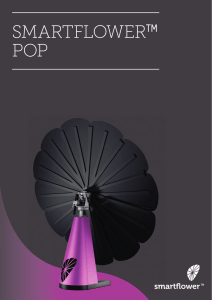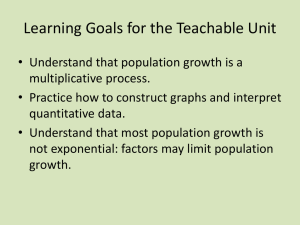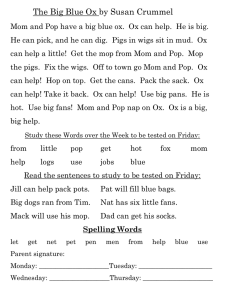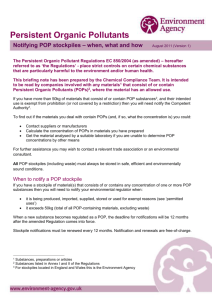Final Review Sheet
advertisement
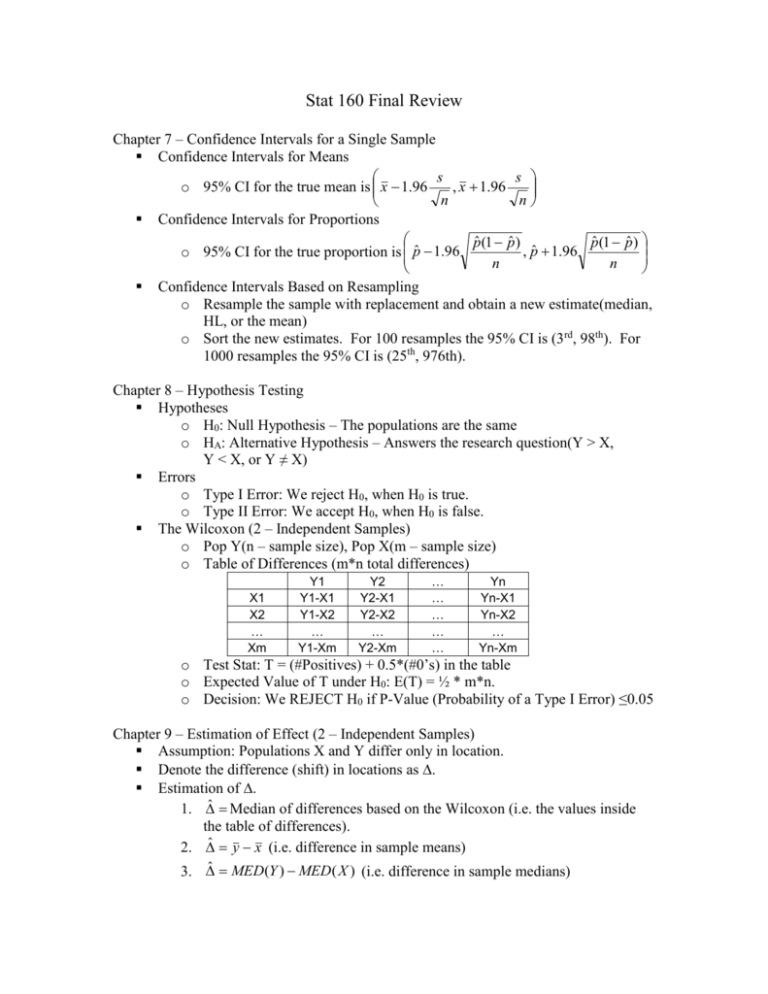
Stat 160 Final Review Chapter 7 – Confidence Intervals for a Single Sample Confidence Intervals for Means s s o 95% CI for the true mean is x 1.96 , x 1.96 n n Confidence Intervals for Proportions pˆ (1 pˆ ) pˆ (1 pˆ ) , pˆ 1.96 o 95% CI for the true proportion is pˆ 1.96 n n Confidence Intervals Based on Resampling o Resample the sample with replacement and obtain a new estimate(median, HL, or the mean) o Sort the new estimates. For 100 resamples the 95% CI is (3rd, 98th). For 1000 resamples the 95% CI is (25th, 976th). Chapter 8 – Hypothesis Testing Hypotheses o H0: Null Hypothesis – The populations are the same o HA: Alternative Hypothesis – Answers the research question(Y > X, Y < X, or Y ≠ X) Errors o Type I Error: We reject H0, when H0 is true. o Type II Error: We accept H0, when H0 is false. The Wilcoxon (2 – Independent Samples) o Pop Y(n – sample size), Pop X(m – sample size) o Table of Differences (m*n total differences) X1 X2 … Xm Y1 Y1-X1 Y1-X2 … Y1-Xm Y2 Y2-X1 Y2-X2 … Y2-Xm … … … … … Yn Yn-X1 Yn-X2 … Yn-Xm o Test Stat: T = (#Positives) + 0.5*(#0’s) in the table o Expected Value of T under H0: E(T) = ½ * m*n. o Decision: We REJECT H0 if P-Value (Probability of a Type I Error) ≤0.05 Chapter 9 – Estimation of Effect (2 – Independent Samples) Assumption: Populations X and Y differ only in location. Denote the difference (shift) in locations as Estimation of 1. ̂ Median of differences based on the Wilcoxon (i.e. the values inside the table of differences). 2. ̂ y x (i.e. difference in sample means) 3. ˆ MED(Y ) MED( X ) (i.e. difference in sample medians) Confidence Interval for o Resample sample Y with replacement and sample X with replacement o Obtain a new ̂ (by 1, 2, or 3 above) o Sort the ̂ ’s. For 100 resamples the 95% CI is (3rd, 98th). For 1000 resamples the 95% CI is (25th, 976th). Difference in independent proportions o Since a proportion is a mean we can use method 2 above to estimate and find a 95% CI. Chapter 10 – Design of Experiments Purpose is to establish Cause and Effect Completely Randomized Designs o See Chapter 8 and Chapter 9 for Test Stat, E(T), estimate, and 95% CI Randomized Paired Designs o Randomly Select n Pairs(ID Twins, Yourself, etc.). Apply T1 to half of the pair(Pop Y) and T2 to the other half of the pair(Pop X) o PopY and Pop X are dependent(Within each pair there is a dependency). o Let D1 = Y1 – X1, D2 = Y2 – X2, …, Dn = Yn – Xn (We now have just 1 sample of differences, the D’s) o Table of Walsh Averages D1 D2 … Dn D1 (D1+D1)/2 x x x D2 (D2+D1)/2 (D2+D2)/2 x x … … … … x Dn (Dn+D1)/2 (Dn+D1)/2 … (Dn+Dn)/2 n(n 1) 2 Test Stat: W = (#Positives) + 0.5*(#0’s) in the table n(n 1) Expected Value of W under H0: E(W) = 4 ̂ HL Estimate (i.e. median of the Walsh Averages) 95% CI – Use chapter 7 on the D’s using the HL as the estimate o Total # of Walsh Averages = o o o o Chapter 11 – Regression Second Pass CRD – Completely Randomized Design o Plot Pop X at x = 0 and Pop Y and x = 1. o LS Fit for yˆ aˆ bˆx Intercept is the average for Pop X Slope is the difference(shift - ̂ ) between Pop Y and Pop X on average 95% CI for the slope is (bˆ 1.96 SE , bˆ 1.96 SE )


